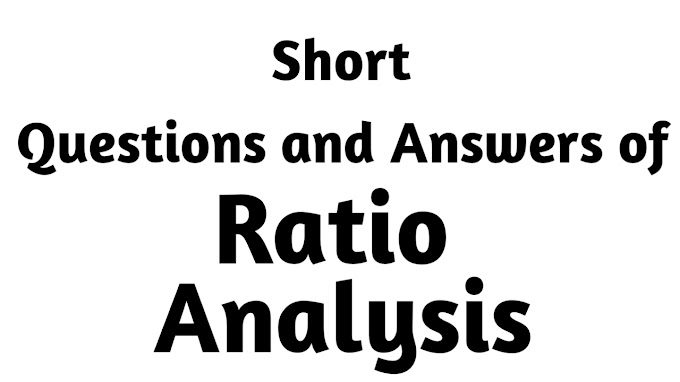Short Questions and Answers of Ratio Analysis
1. What do you mean by ratio analysis?
Answer-: Ratio analysis is the most widely used technique for
interpreting and comparing financial reports. It analyses financial data from
the firm’s Profit and Loss Account and Balance Sheet.
2. Why is ratio analysis necessary?
Answer-: Ratio Analysis is necessary for the following reasons,
(i) To allow comparisons to be made which assist in predicting the
future.
(ii) To investigate the reasons for the changes.
(iii) To construct a simple explanation of a complicated financial
statement by its expression in one figure.
(iv) To permit the charting of a firm’s history and the evaluation of
its present position.
3. State two advantages of ratio analysis.
Answer-: The two advantages of ratio analysis are the following
(i) It is used as an aid to simplify the comprehension of financial
statements.
(ii) It is used as an aid to analysis and interpretation of financial
statements.
4. State two limitations of ratio analysis.
Answer-: Two limitations of ratio analysis are as follows:
(i) Financial statement suffers from a number of limitations. When
ratios are constructed from those financial statements, ratios suffer from the
inherent weakness of the accounting system itself.
(ii) By using ratios, forecast of future of a business may not be prove
correct. This is because, ratios are all based on past happenings and not
future probabilities. They are subject to changes in the future.
5. Who are users of ratio analysis?
Answer-: Users of ratios can be classified into two
groups – internal and external. Internal group consists of directors,
shareholders, partners, managers, etc. External group consist of investors,
lenders, suppliers, employees, labour union, customers, etc.
6. Give the examples of Current Assets.
Answer-: Examples of Current Assets are:
1. Cash in Hand
2. Cash at Bank
3. Cash Equivalents
4. Short-term Investment
5. Tread Debtors
6. Bills Receivables
7. Accrued Income
8. Prepaid Expenses
9. Stock in Tread
10. Advance Tax
7. Give the Examples of Current Liabilities.
Answer-:
Examples of Current Liabilities are
1. Trade Creditors
2. Bills Payable
3. Liability for Taxes
4. Outstanding Expenses
5. Income received in advance
6. Provision for Taxation
7. Proposed Dividend
8. Short-term Bank Loan (e.g., cash credit,
overdraft etc.)
9. Current Portion of Long-term Loan.
8. What is Quick Ratio?
Answer-:
The quick ratio is the relationship between quick assets and quick liabilities.
Quick assets are all those assets which in ordinary course of business will be
converted into cash. Therefore, quick assets are current assets less stock and
prepaid expenses, i.e., cash, bank, debtors and readily realisable marketable
securities.
9. What is Current Ratio?
Answer-:
Current Ratio is the relationship between current assets and current
liabilities. It is quoted as a single figure (not percentage). Current assets
are cash, cash equivalents and other assets which are expected to be realised
in cash or sold or consumed within one year (or the normal operating cycle of
the company if it is greater than one year). On the other hand, current
liabilities are the obligations of the business which are repayable within a
relatively short period of time, usually one year.
10. Why is stock deducted from current assets at the time of calculating quick ratio?
Answer-: The quick ratio does
not take into consideration stock because they are normally sold on credit
(converted into a debtor) and then the debtor must be collected before cash is
paid.
Another
reason is that a firm must maintain a minimum level of stock at point of time.
11. What is interest coverage ratio?
Answer-: The interest coverage
ratio is the relationship between EBIT (Earning Before Interest and Tax) and
interest payable. It indicates the capacity of the organisation to pay interest
to lender regularly.
EBIT is the profit after changing
all expenses including depreciation but before changing interest and income
tax.
12. What is debtors turnover ratio?
Answer-: Debtors turnover
ratio is the ratio between the credit sales (if the information is regard to
credit sales is not available, total sales may be taken in the place of credit
sales) and average debtors plus average
bills receivable. The ratio indicates the number of time per year that the average
balance of debtors are collected.
13. What is stock turnover ratio?
Answer-: Stock turnover ratio
is the ratio between the stock of finished goods and the cost of goods sold.
The stock turnover ratio measures how quickly stock is sold, i.e., the number
of times of a company’s stock turnover ratio during a year.
14. What is operating profit ratio?
Answer-: Operating profit
ratio is the relationship between operating profit and sales. Operating profit
is calculated after deducting operating expenses from gross profit. N non
operating profits such as dividend / interest from investment are taken into consideration.
15. What is operating ratio?
Answer-: Operating ratio is
the ratio between ‘cost of goods sold plus
operating expenses per rupee of sales. It is expensed as a percentage of
sales.
16. What is the significance of debt-equity ratio?
Answer-: Debt equity ratio
measures the contribution of lenders relative to the contribution of owners.
Debt equity ratio is also used as a measure of debt exposure, i.e., the extent
to which the firm has been financed by debt.
17. How to debt-equity ratio can be improved?
Answer-: Debt equity ratio can
be improved in the following manner:
(1) By increasing share capital
(2) By paying long-term debts
18. What is creditors turnover ratio?
Answer-: Creditors turnover
ratio is the ratio between the credit purchase (if the information in regard to
credit purchase is not available, total purchase may be taken in place of
credit purchase) and average creditors plus
average bills payable. This ratio indicates the numbers of times per year
that the average balances of creditors are paid.
19. What is proprietary ratio?
Answer-: Proprietary ratio is
the ratio between shareholder’s funds and total assets. This ratio shows the
proportion of total assets of a business financed by shareholders’ fund.
20. State the significance of high debt-equity ratio.
Answer-:
High debt-equity ratio is not good for the organisation particularly when the demand
for the product is not good. Majority portion of the revenue will be required
for paying the interest on loan. The organisation will also face problem for
getting future loan.


















0 Comments